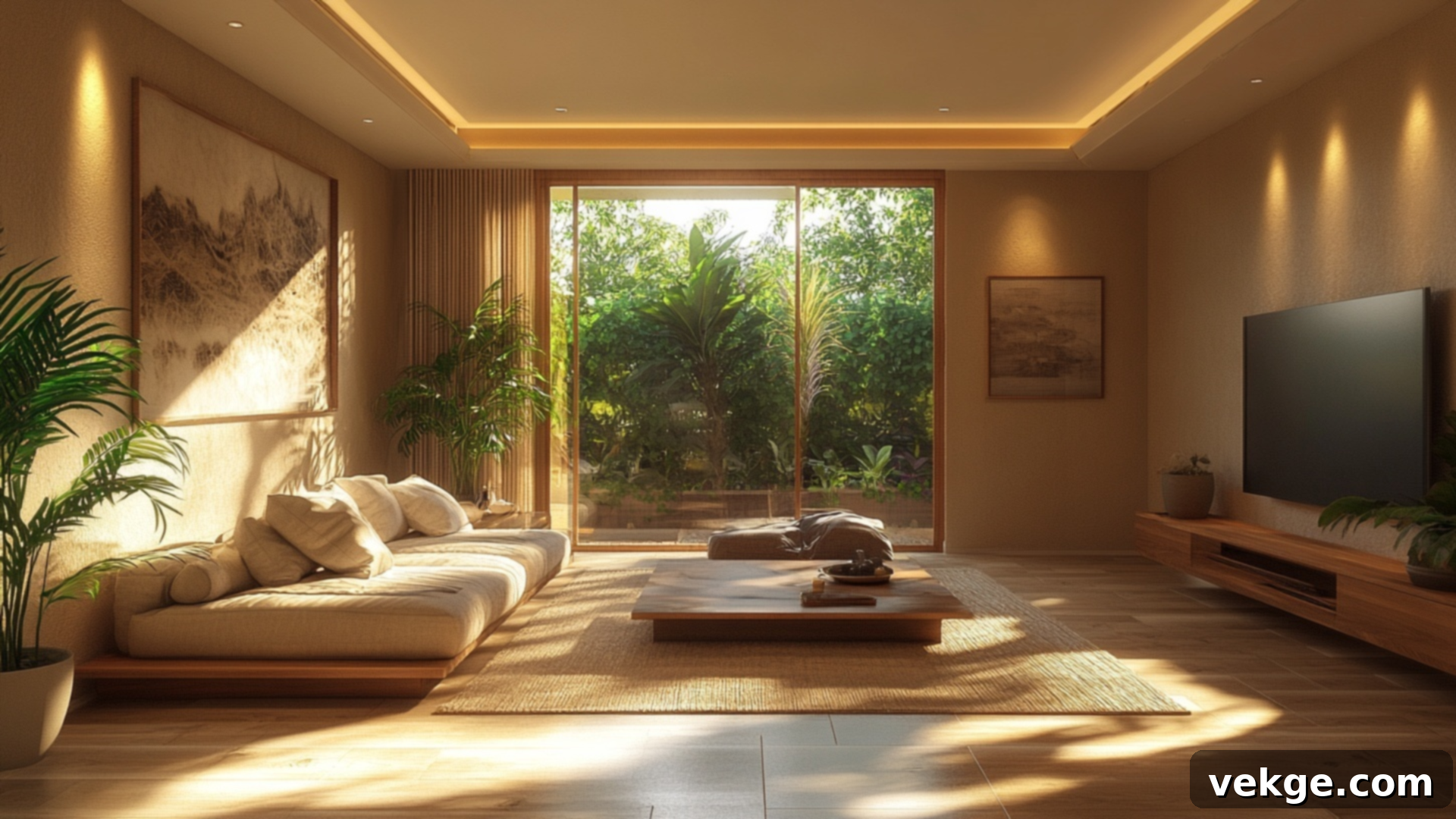Mastering Feng Shui Room Layouts: Create a Balanced & Peaceful Home Environment
Do you ever walk into your home and feel a subtle sense of unease, or perhaps a lingering feeling that something just isn’t quite right? Many of us experience this without fully understanding the cause. Often, the unseen culprit is the flow of energy within our living spaces. This vital energy, known as Chi in the ancient practice of Feng Shui, profoundly influences our mood, health, and overall well-being.
Implementing a thoughtful Feng Shui room layout isn’t just about rearranging furniture; it’s a powerful way to invite balance, calm, and renewed comfort into every corner of your home. It’s a holistic approach that transforms your environment into a supportive sanctuary, rather than a source of subtle stress.
In this comprehensive guide, we’ll dive deep into the core principles of Feng Shui, exploring how this ancient wisdom can be applied to each room in your house. We’ll uncover the secrets behind strategic furniture placement, the psychological impact of colors and lighting, and the often-underestimated role of decluttering in shaping your home’s energy. You’ll discover practical layout ideas, invaluable decluttering tips, and crucial common mistakes to steer clear of.
Our goal is simple: to empower you to create a home that not only looks beautiful but genuinely feels more peaceful, supportive, and aligned with your personal goals. Let’s begin the journey to a more harmonious living space.
Understanding Feng Shui for Your Space: Harnessing the Power of Chi
Feng Shui, an ancient Chinese art and science, literally translates to “wind and water.” It’s a profound practice focused on creating harmony and balance in our living and working environments by optimizing the flow of life force energy, known as Chi. When Chi flows freely and gently through your home, it creates a nourishing atmosphere that supports every aspect of your life.
A well-balanced flow of Chi promotes restful sleep, enhances emotional well-being, fosters productivity, and cultivates a sense of calm and healing. It helps reduce stress, encourages clearer thinking, and can even attract greater prosperity and positive relationships into your life.
Conversely, stagnant or chaotic energy can lead to feelings of stress, discomfort, restlessness, and even hinder personal growth. By thoughtfully applying basic Feng Shui principles, you can consciously design your environment to become a source of positive energy, transforming your house into a truly supportive and peaceful home.
Core Feng Shui Principles to Guide Your Home Design
These fundamental principles are not just decorative tips; they are practical guidelines designed to enhance the energy and overall well-being within your living space. Integrating them thoughtfully will lay the groundwork for a harmonious home.
1. Achieve Balance Through Symmetry and Harmony
At the very heart of Feng Shui is the concept of balance. Symmetry creates a visual and energetic sense of equilibrium, making a room feel stable and welcoming. Strive to arrange furniture in pairs or with even spacing. For instance, two nightstands flanking a bed, or two accent chairs mirroring each other across a coffee table, effectively achieve a symmetrical setup.
This balanced arrangement allows Chi to move smoothly and evenly, preventing energy from pooling or rushing erratically. It fosters a feeling of calm and order, which directly translates to a more relaxed state of mind for the occupants. Avoid pushing all your furniture or decorative elements to one side of a room, as this can create an energetic imbalance and a feeling of incompleteness.
2. Embrace Clutter-Free Spaces for Clear Energy
Clutter is one of the biggest deterrents to positive Chi flow. It creates energetic blockages, fosters feelings of stress, overwhelm, and stagnation. Making a conscious effort to regularly tidy up and assign a proper, organized home for every item is paramount in Feng Shui.
Open, organized spaces invite fresh energy to circulate freely, promoting clarity, focus, and emotional lightness. When your physical environment is clear, your mind often feels clearer too, leading to reduced stress and enhanced mental well-being. Think of it as creating clear pathways for prosperity and positive experiences to enter your life.
3. Master Strategic Furniture Placement for Security and Flow
The placement of your furniture is far more than an aesthetic choice; it deeply impacts your sense of security, support, and control within a space. The “commanding position” is key: ensure your main furniture pieces (like your bed, desk, or sofa) are placed against a solid wall, allowing you a clear, unobstructed view of the room’s entrance.
For example, placing your bed against a solid wall with a clear, but not direct, view of the door promotes calm, safety, and a sense of being supported. Conversely, avoid placing your bed or other key furniture directly under windows (which can feel unsupported) or in direct alignment with doors, as this can cause Chi to rush out or in too quickly, leading to disrupted energy flow and feelings of vulnerability.
4. Integrate Natural Elements to Ground and Refresh
Bringing elements of nature indoors is a powerful way to restore balance and vitality to your home. Incorporate living plants, furniture made from natural wood, soothing water features, and maximize access to natural light. These elements are not merely decorative; they are conduits of life energy.
Plants purify the air and introduce vibrant, growing Chi. Wooden furniture provides grounding and stability. Natural light invigorates and uplifts. Together, these elements make your room feel more connected to the earth, peaceful, and vibrantly alive, fostering a deeper sense of well-being and natural rhythm.
By thoughtfully applying these simple yet profound Feng Shui tips, you can transform your space into an environment that not only looks appealing but also actively supports your well-being, inviting positive energy and greater harmony into every aspect of your daily life.
Feng Shui Room Layout Ideas for Every Space in Your Home
Applying Feng Shui principles to specific rooms can profoundly enhance their function and the energy they contribute to your life. Even a few smart adjustments can make any room feel more welcoming, comfortable, and supportive. The goal is to strategically place items to optimize comfort, energy flow, and overall mood. Here are practical ways to bring balance to each space in your home:
1. Living Room Layout for Family Peace & Connection
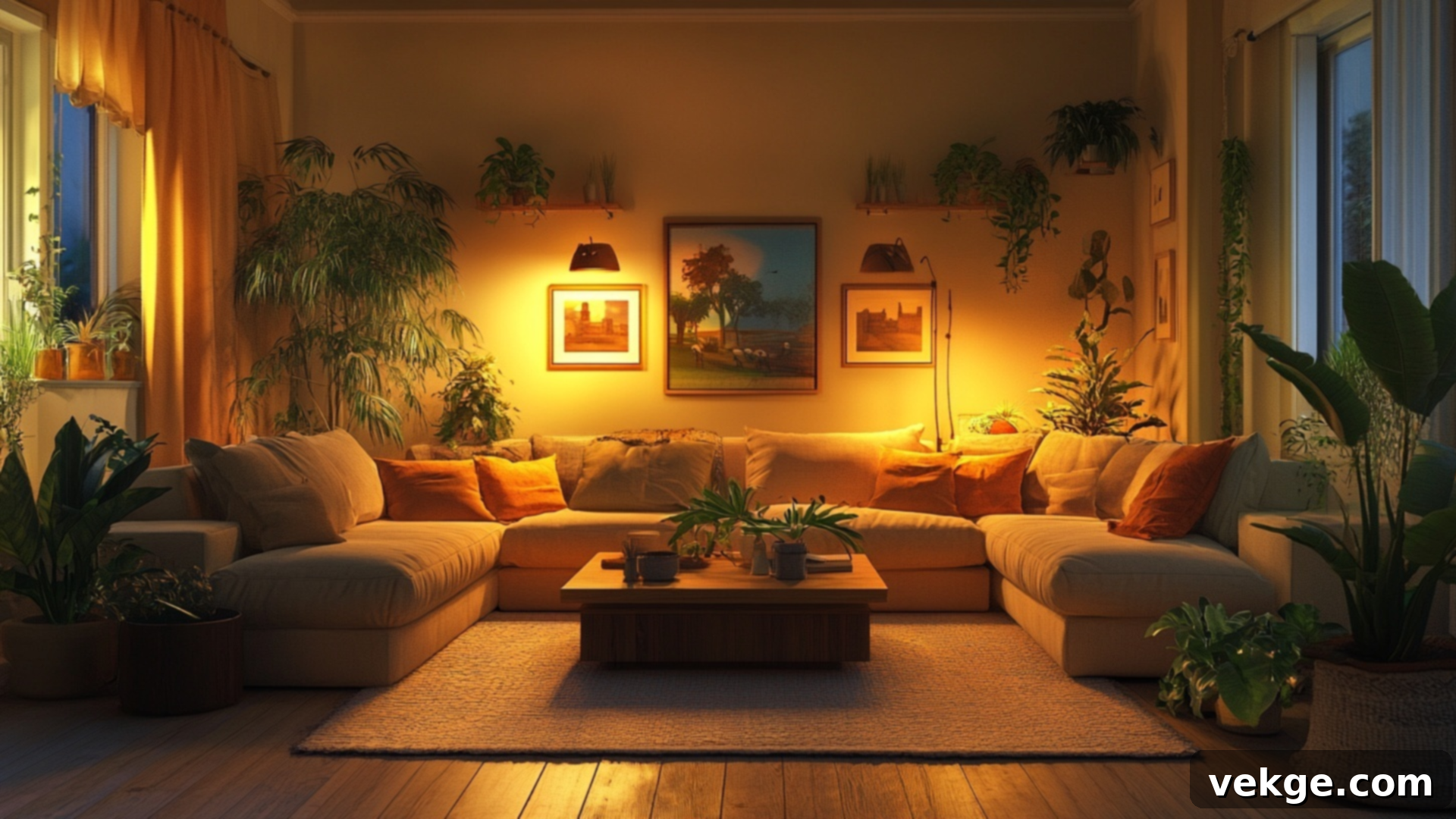
The living room is the heart of family interaction and social connection. To foster harmony, arrange seating in a welcoming configuration that encourages conversation, such as a U-shape or a gentle circular arrangement. Ensure that sofas and chairs face each other rather than just the TV, promoting engagement and connection among occupants.
Crucially, avoid positioning seating with its back directly to the main door or pathway. This can create a feeling of vulnerability or unease. Instead, arrange furniture so that everyone feels supported, included, and can easily engage with one another. Incorporate soft lighting and comfortable textiles to enhance the welcoming atmosphere.
2. Kitchen Layout for Health, Nourishment & Prosperity
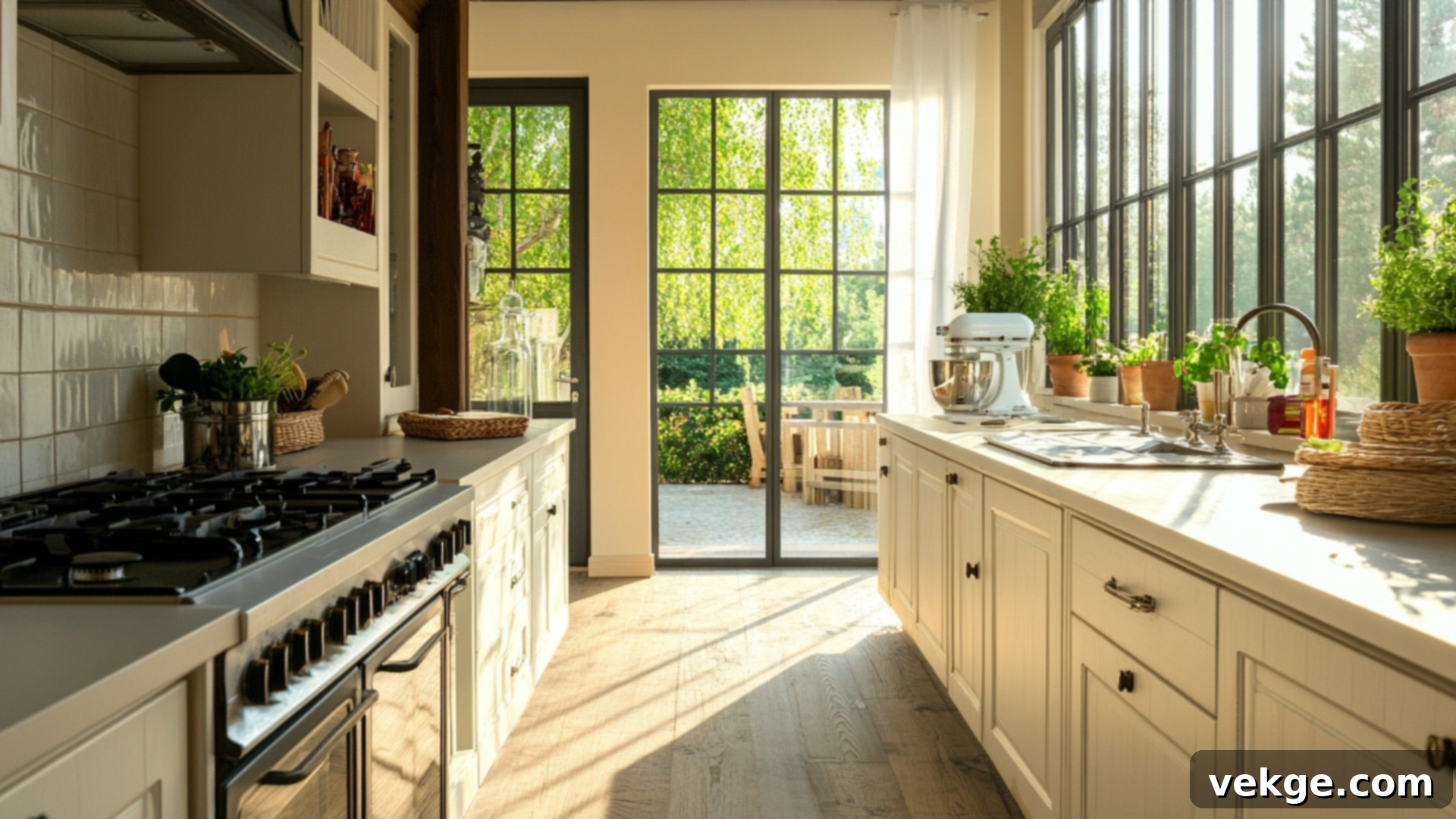
The kitchen represents nourishment and abundance in Feng Shui. For optimal health and prosperity, it’s ideal to place your stove (representing wealth) in a “commanding position” where you can see the kitchen entrance while cooking. This symbolizes control and security over your resources. If this isn’t possible, use a mirror strategically placed to achieve this view.
Maintain clear and spacious counters to allow energy to flow freely, which supports efficient cooking and a sense of calm. Store items in an organized manner, minimizing clutter, especially on cooking surfaces. A consistently clean and tidy kitchen not only promotes good hygiene but also actively attracts positive energy and prosperity into your home.
3. Dining Room Layout for Connection & Sustenance
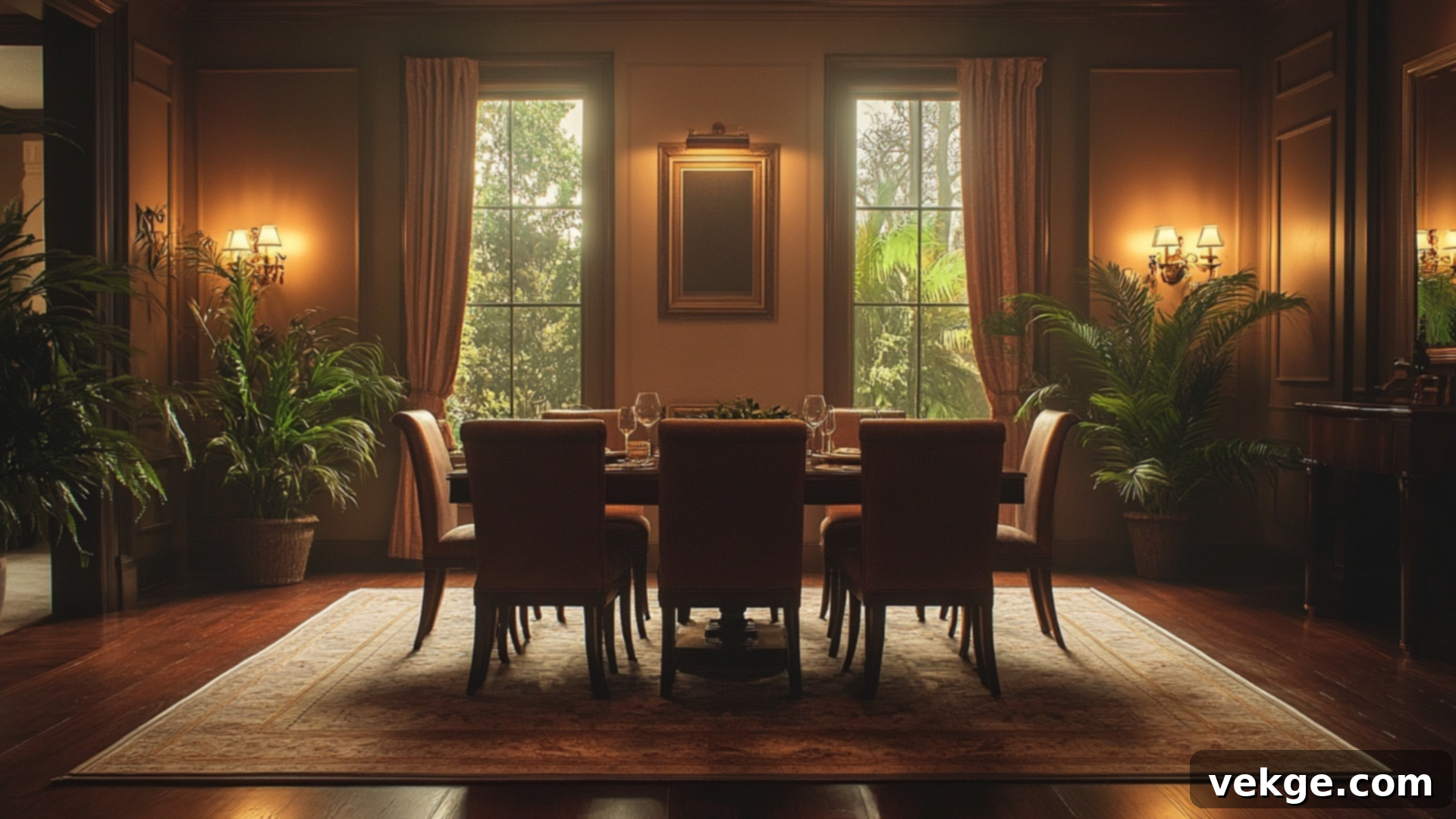
The dining room is a place for sharing meals, conversation, and strengthening family bonds. Encourage intimacy and connection by seating family members and guests close together, ensuring no one feels isolated or left out. A round or oval table can naturally facilitate better conversation flow.
Position the dining table centrally within the room, ensuring there’s ample space to move around it comfortably. Avoid placing the table directly under a visible beam or a low-hanging chandelier, which can create oppressive energy. Instead, opt for soft, inviting overhead lighting or sconces to create a warm, inviting atmosphere that encourages pleasant conversation, digestion, and positive energy during meals.
4. Bedroom Layout for Rest, Relaxation & Rejuvenation
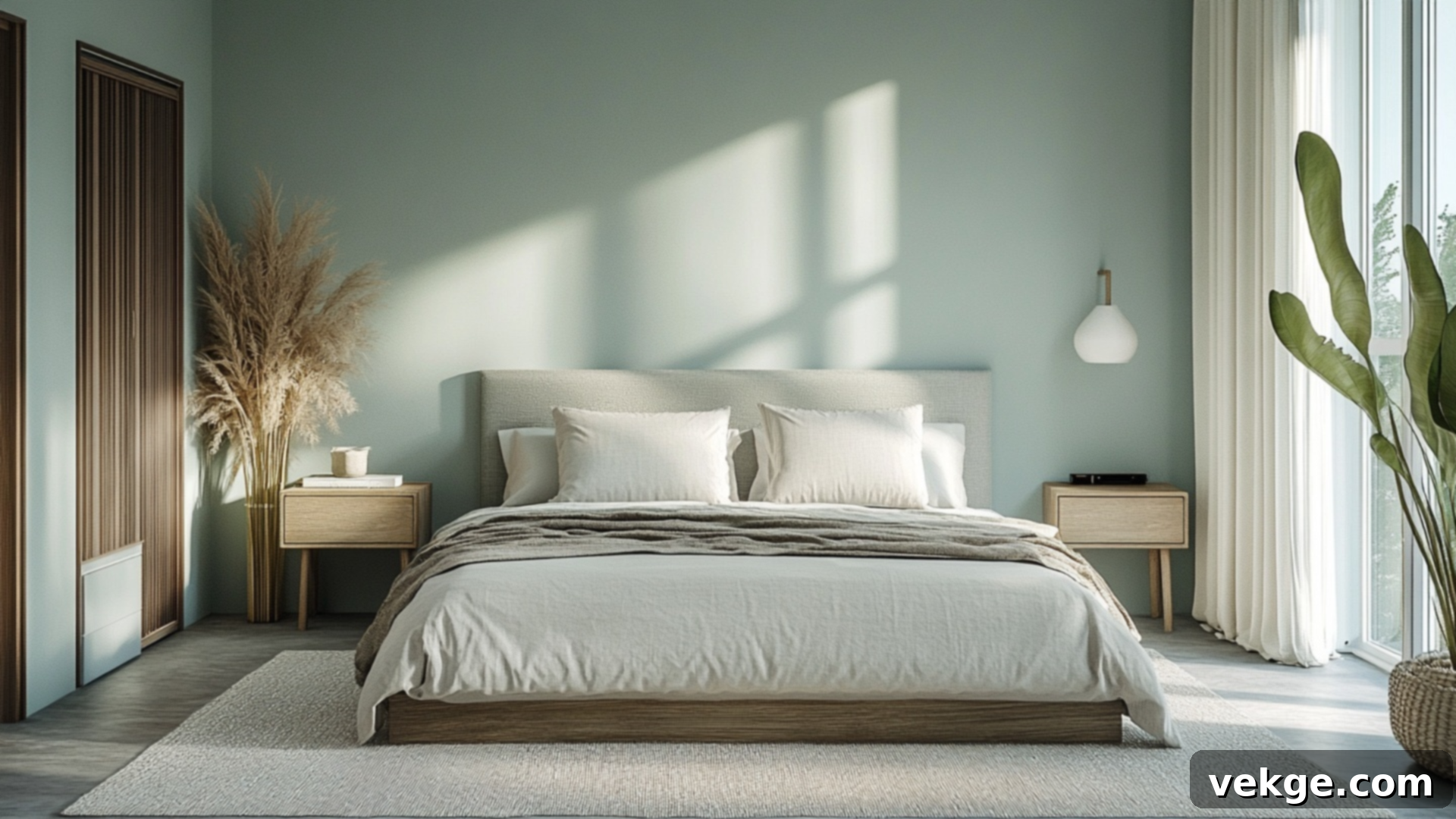
The bedroom is your personal sanctuary for rest, intimacy, and rejuvenation. The most critical element is the bed’s position. Place the bed against a solid wall, providing a sense of support and security. Ideally, you should have a clear, commanding view of the door from your bed, but without being directly in line with it, which can cause Chi to rush past too quickly.
Ensure there’s space on both sides of the bed, complemented by two nightstands or small tables, to promote balance and equality in a relationship (or self-balance). Avoid placing electronic devices directly beside or under the bed, as their electromagnetic fields can disrupt sleep. Opt for soft, calming colors, natural textures, and gentle lighting to create a truly tranquil and restful environment, conducive to deep sleep and peace.
5. Home Office Layout for Focus, Productivity & Career Growth
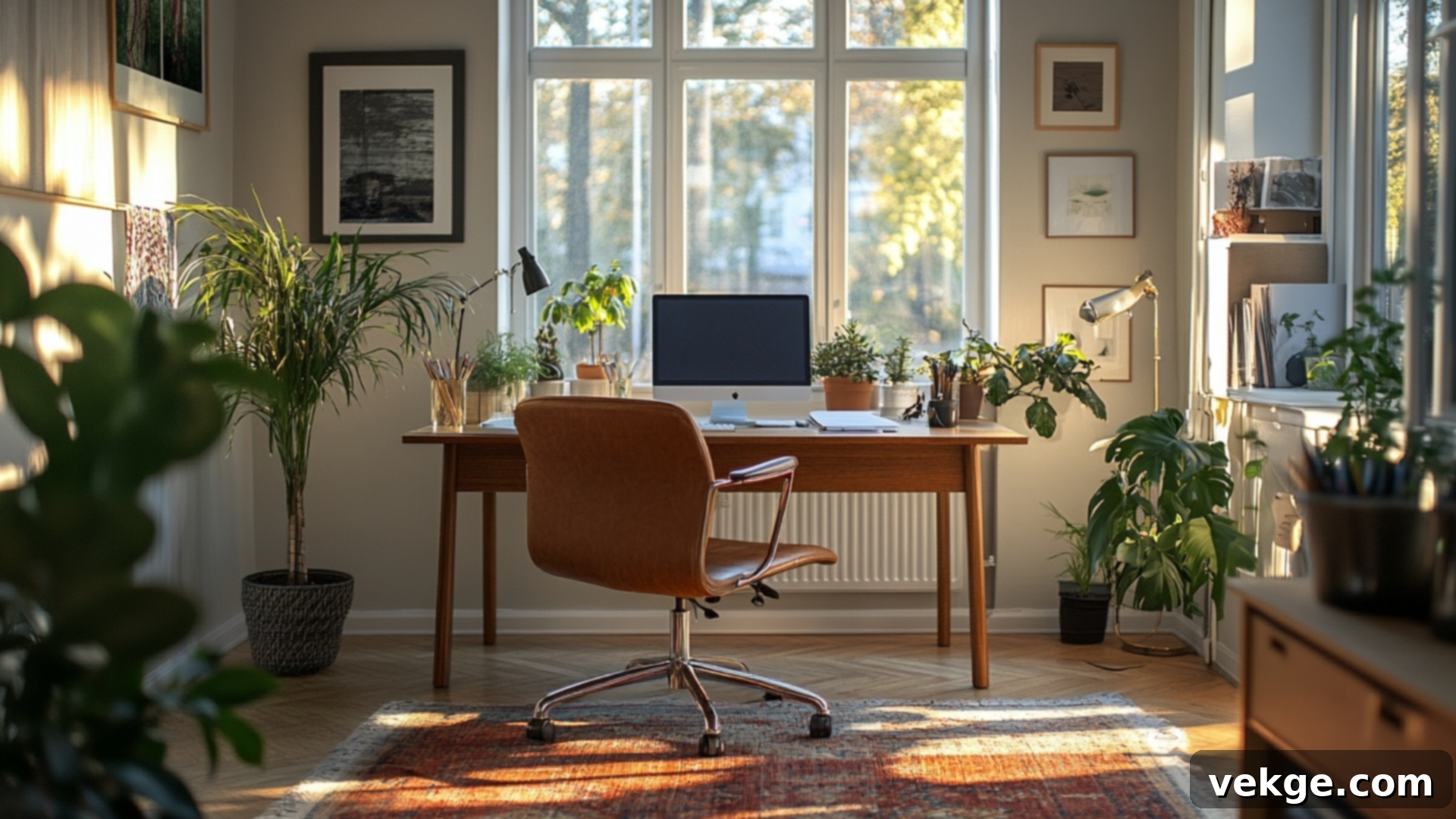
Your home office should be a hub of inspiration, focus, and productivity. Position your desk in the “commanding position” – against a solid wall with a clear view of the door, but not directly in its path. This gives you a sense of security and control over your work environment, preventing distractions and promoting focused thinking.
Maintain a highly organized workspace with minimal clutter; a clear desk encourages a clear mind. Avoid facing a blank wall, as this can stifle creativity and limit your perspective. If unavoidable, place an inspiring piece of art or a mirror to expand the view. Maximize natural light and incorporate elements like plants to enhance focus, vitality, and positive energy flow, supporting your career growth and daily tasks.
6. Bathroom Layout for Cleansing Energy & Renewal
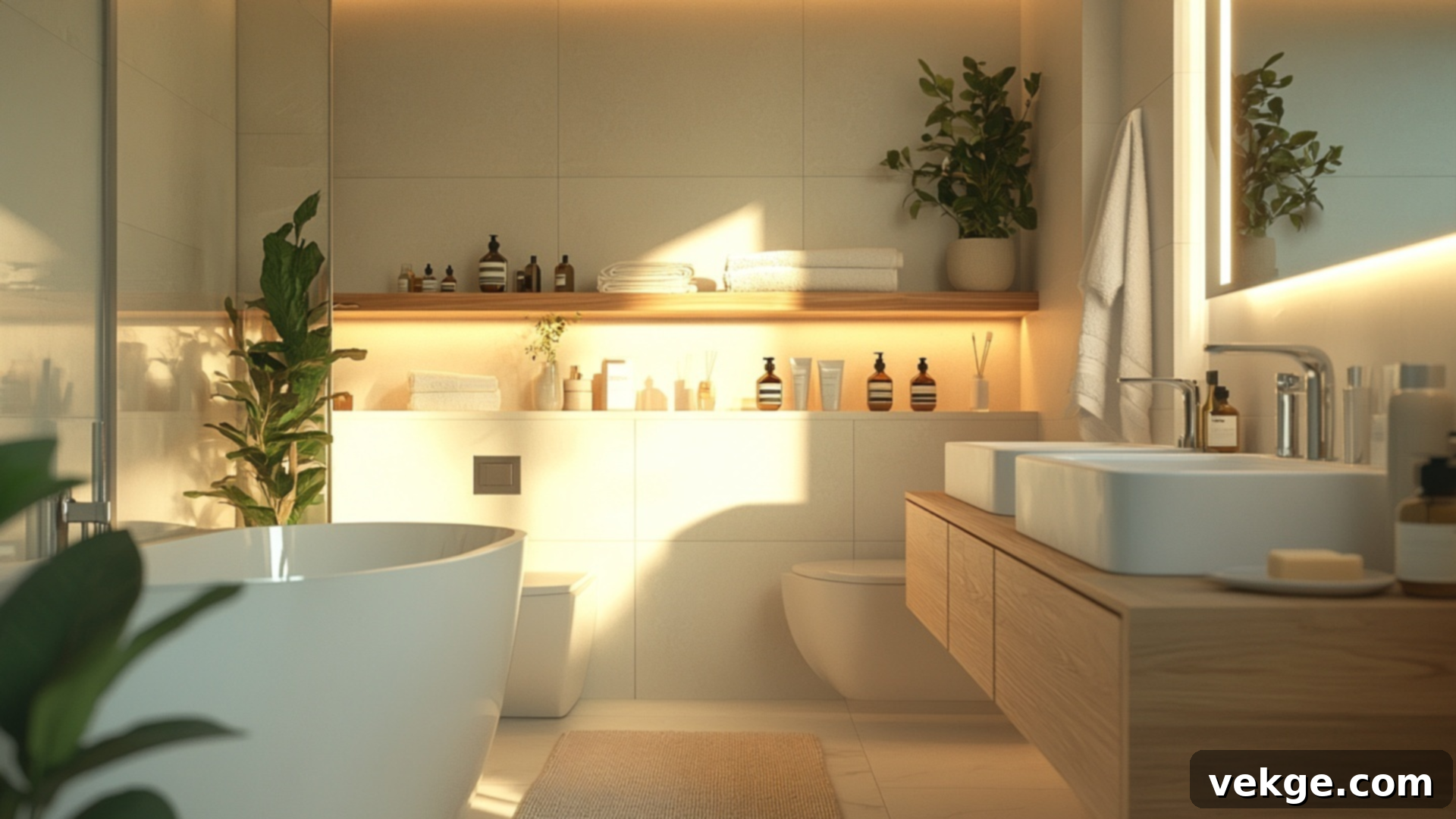
While essential for cleansing, bathrooms can also be areas where energy (and prosperity) can quickly drain. To mitigate this, avoid placing mirrors directly facing the bathroom door, as this can symbolically push positive energy out. Keep the toilet lid down when not in use, and ensure the door remains closed.
Prioritize cleanliness and an uncluttered environment to prevent stagnation and promote positive energy. Use calming colors, natural materials like wood or stone, and ensure fixtures are well-maintained and organized. Adding a plant can help absorb negative energy and introduce vitality. Create a refreshing and serene atmosphere that promotes renewal without disrupting the overall flow of Chi in your home.
7. Entryway Layout for Positive First Impressions & Welcoming Chi
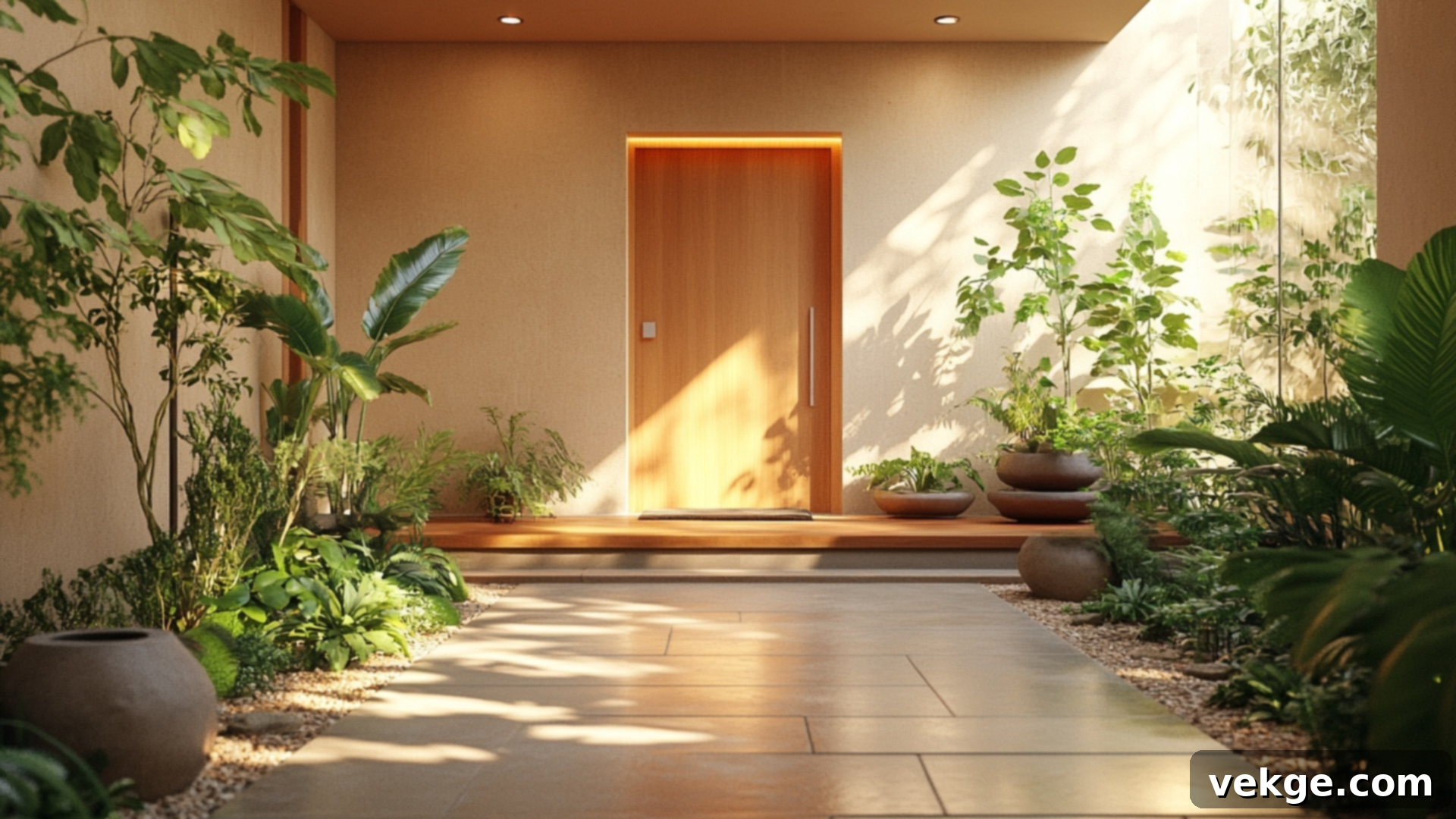
The entryway, or Foyer, is where Chi first enters your home, making its layout crucial for welcoming positive energy. Make this area as inviting as possible with elements like lush plants, warm and soft lighting, and calming colors. A clear, well-lit entrance allows good energy to flow freely and smoothly throughout your home.
Absolutely avoid clutter here, as shoes, coats, and mail can block incoming energy. Ensure the space is always tidy and bright, creating a strong first impression for both visitors and the energy itself. A well-placed mirror (not directly facing the door) can expand the space and reflect good energy, while a small rug can define the welcoming zone.
8. Feng Shui for Small Spaces: Maximizing Energy & Openness
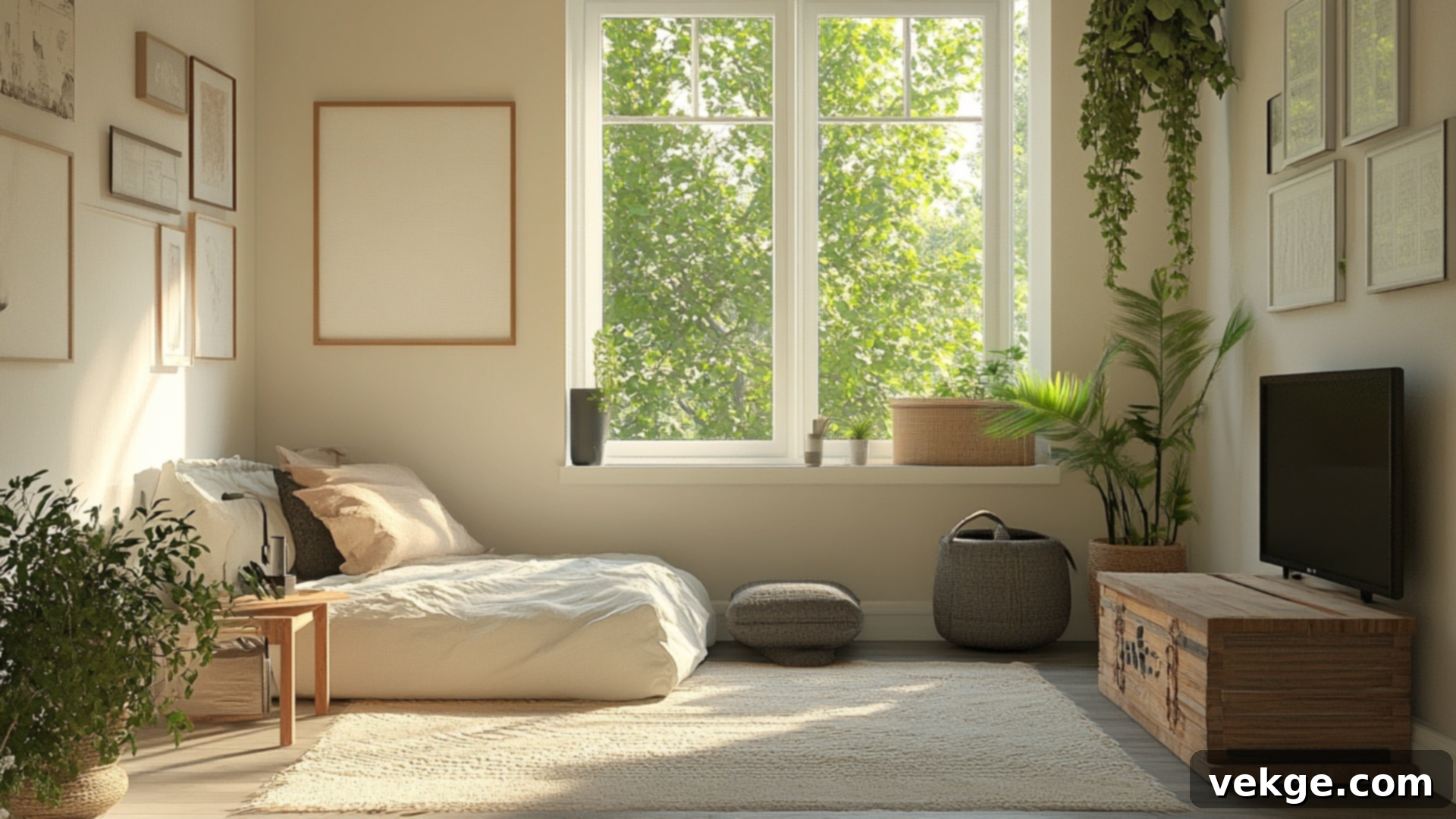
In small spaces, maximizing energy flow and creating a sense of expansiveness is key. Choose multi-functional, space-saving furniture to prevent overcrowding. The golden rule here is to relentlessly keep the room clutter-free, as even small amounts of clutter can feel overwhelming in a compact area.
Opt for lighter colors on walls and furniture to visually expand the space and make it feel brighter and more open. Arrange furniture strategically to allow for smooth, unobstructed movement – ensure pathways are clear. Use mirrors to reflect light and create the illusion of more space. The goal is to make the space feel both functional and comfortable, allowing Chi to circulate effortlessly without feeling trapped.
9. Feng Shui for Open Floor Plans: Defining Zones & Flow
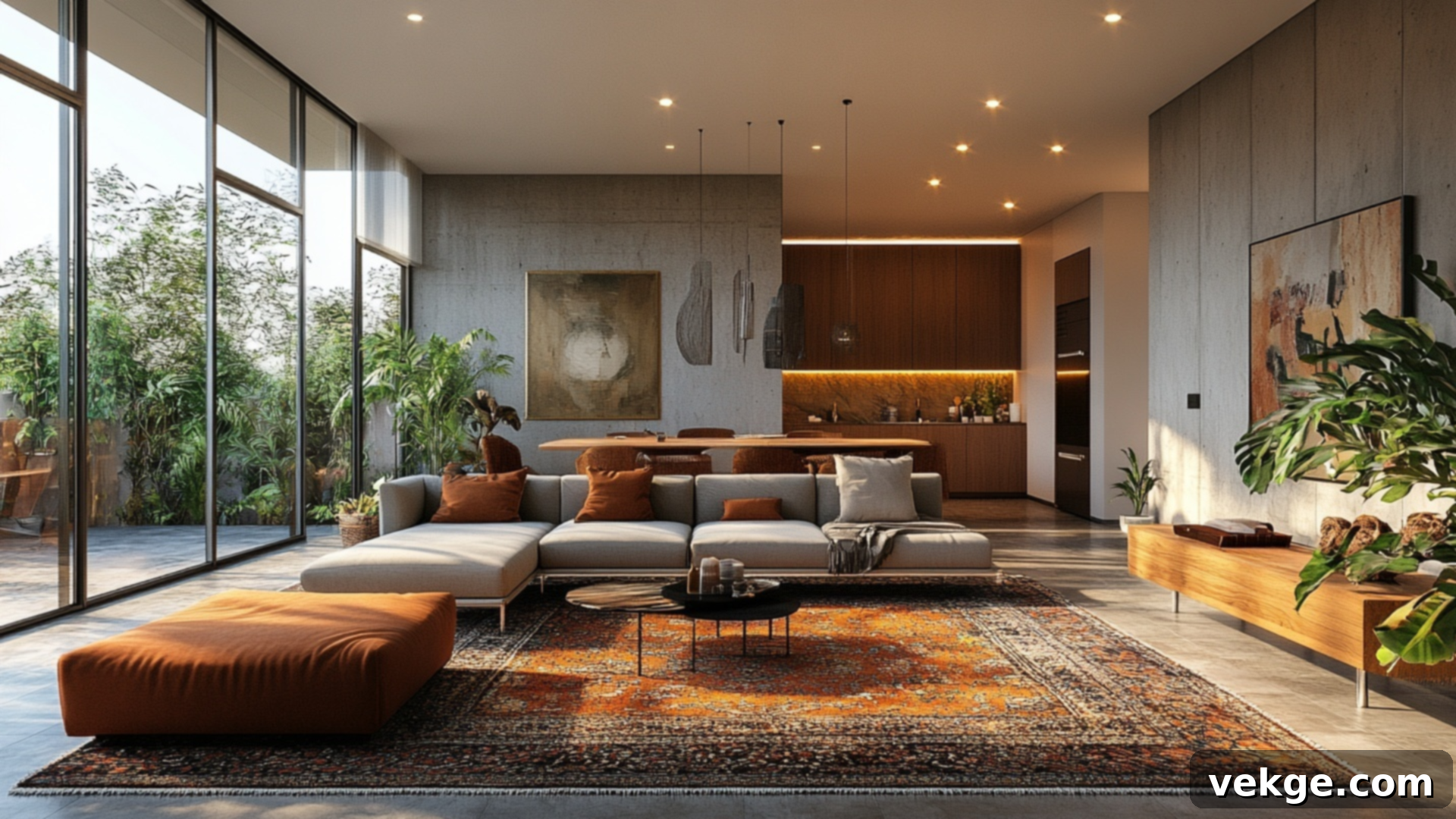
Open-concept living spaces can sometimes feel like a continuous rush of energy. The key is to create distinct zones for different activities while maintaining an overall sense of flow. Use furniture, rugs, and strategic lighting to subtly define areas for living, dining, and working without erecting physical walls.
Ensure that furniture is placed to promote gentle energy circulation rather than allowing Chi to rush straight through. For example, a sofa can act as a natural divider between a living area and a dining space. Keep the entire area open and clutter-free to prevent stagnation. Using area rugs or varying lighting levels can further delineate spaces and ensure a balanced, comfortable energy flow throughout your expansive home.
10. Feng Shui for Hallways and Corridors: Guiding Energy Smoothly
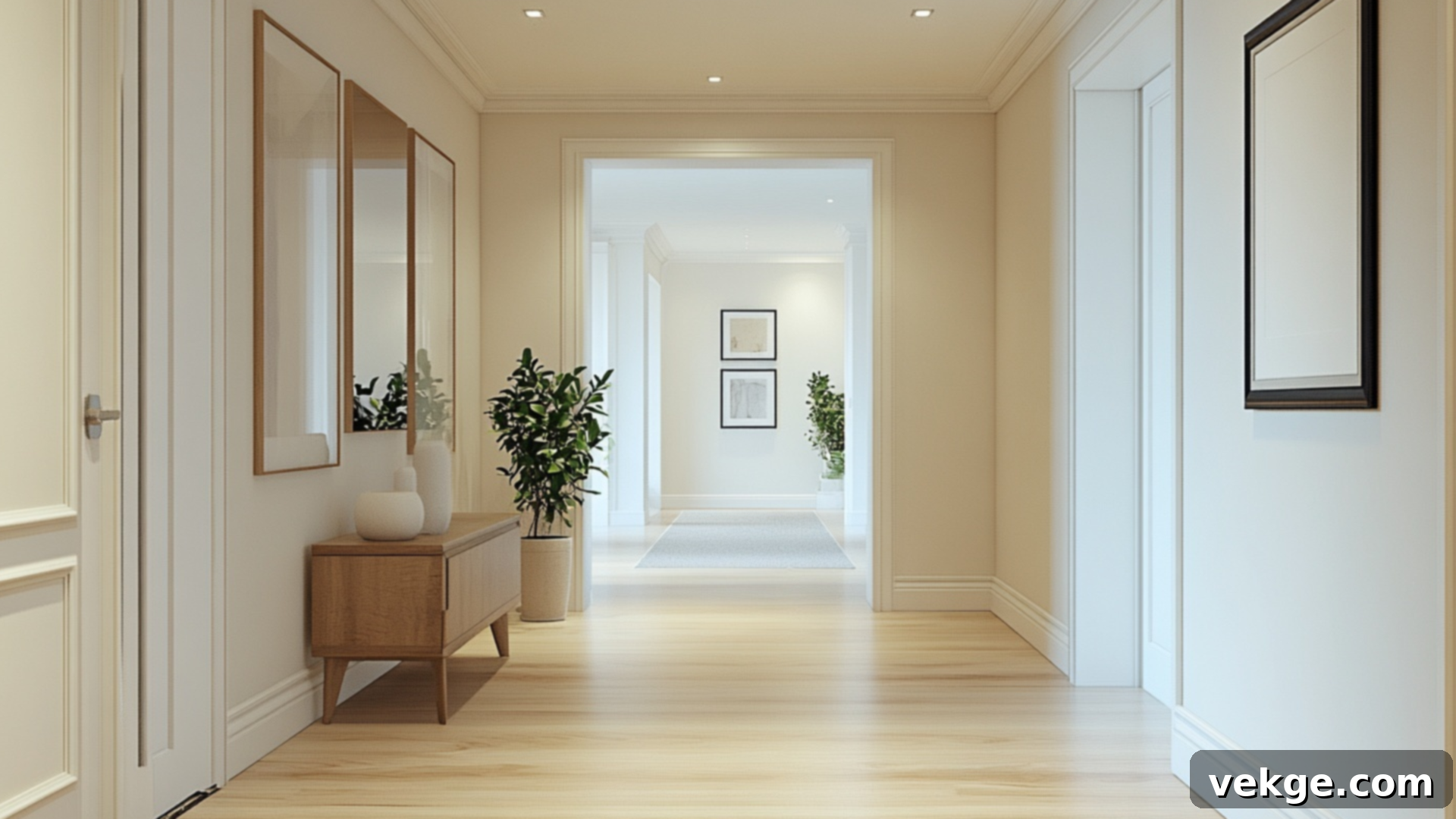
Hallways and corridors are the arteries of your home, connecting different spaces. Keeping them clear of clutter is paramount to allow energy to flow smoothly and unobstructed between rooms. A blocked hallway can cause energy stagnation, affecting the entire home.
Use light colors on the walls to brighten narrow spaces and enhance the feeling of openness. Adding well-placed artwork or mirrors (ensuring they don’t reflect directly into other rooms in a disruptive way) can help guide and enhance the flow of Chi. Avoid placing large furniture pieces or excessive decor in narrow hallways, as this can impede movement and create a sense of being squeezed, leading to stagnation and discomfort.
11. Feng Shui Layout for Pet-Friendly Spaces: Harmony for All Inhabitants
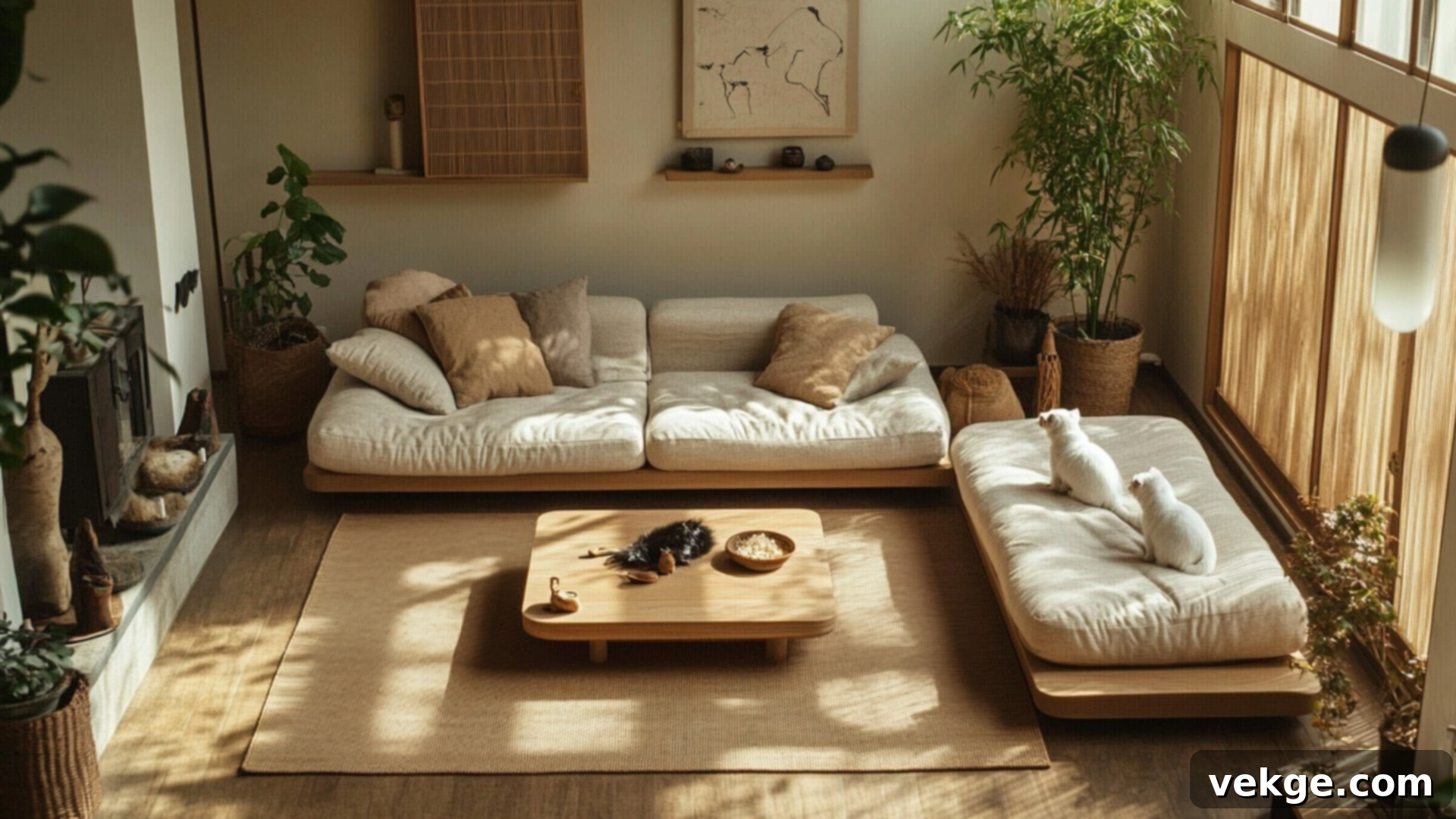
Pets bring joy and vibrancy to a home, and Feng Shui can help create a harmonious environment for both human and animal inhabitants. Ensure your beloved pets have their own designated, comfortable areas that are integrated into the home’s flow but don’t obstruct major pathways or commanding positions.
Choose natural, easy-to-clean materials for pet beds and accessories. Keep their feeding and resting spaces tidy and clean, just as you would any other part of your home, to prevent stagnant energy. Arrange furniture to allow for free movement for both pets and humans, ensuring a balanced and respectful atmosphere where everyone, including your furry friends, feels comfortable, secure, and part of the positive energy flow.
Choosing the Right Colors and Lighting for Optimal Feng Shui
Beyond aesthetics, the colors and lighting you select for your home deeply influence its energetic atmosphere and how each room feels and functions. These elements play a vital role in balancing the Five Elements of Feng Shui (Wood, Fire, Earth, Metal, Water) and shaping your emotional and physical responses to a space.
For spaces dedicated to rest and tranquility, such as bedrooms, embracing soft, muted colors like blues (Water element, for calm) or greens (Wood element, for growth and healing) can help you unwind and achieve deeper sleep. In areas where you desire energy and focus, like a home office or creative studio, consider light yellows (Earth element, for stability and warmth) or crisp whites (Metal element, for clarity and precision) to stimulate alertness and mental clarity.
In social and shared areas like the living room or dining room, warm earth tones (Earth element, for grounding and nurturing) and inviting neutrals create a welcoming, stable, and easy-to-relax-in ambiance. Reds (Fire element, for passion and energy) can be used as accents to spark conversation and warmth but should be used sparingly in areas meant for calm.
Lighting is equally crucial and often overlooked. Instead of relying solely on harsh overhead lighting, layer different types of illumination to create dynamic and flexible moods. Use ambient lighting (e.g., floor lamps, diffuse ceiling lights) for a soft, general glow that fills the room with gentle Chi. Incorporate task lighting (e.g., desk lamps, kitchen under-cabinet lights) for specific activities like reading or cooking, providing necessary focus without straining the eyes. Finally, accent lighting (e.g., spot lights, picture lights) can highlight cherished artwork, plants, or architectural features, adding depth and visual interest.
When you thoughtfully combine these lighting layers with a conscious color palette, you cultivate the perfect mood and optimize the energy for every distinct function within your home.
How to Declutter for Better Energy Flow and a Lighter Home
Decluttering is perhaps the most immediate and impactful way to improve the Chi in your home. It’s not just about tidiness; it’s about removing energetic blockages and creating space for new, positive experiences to enter your life. Embrace these steps to create a truly unburdened and harmonious environment:
- Purposeful Purging: Approach your belongings with intention. As you sort through each item, ask yourself: “Do I frequently use this? Does it bring me joy? Does it support my current life goals?” Be honest and brave. Let go of items that no longer serve a purpose, are broken, or evoke negative feelings. This act of releasing creates tangible open space and significantly lightens your mental and emotional load.
- Mindful Display: After purging, be selective about what remains on display. Only showcase decor, artwork, or keepsakes that genuinely spark joy, have deep meaning, or serve a clear function. Too many visual distractions can scatter energy, create a feeling of busyness, and prevent your mind from truly relaxing in a space. Less is often more when it comes to visual harmony.
- Strategic Storage Solutions: For items you use but don’t need on constant display, invest in clever storage solutions. Choose attractive baskets, bins, or closed cabinets and drawers to conceal lesser-used items. Group like items together so you can easily find what you need without rummaging or disrupting the room’s overall harmony. Organized storage is key to maintaining a clutter-free appearance.
- Cultivate Surface Clarity: Make it a habit to keep countertops, desks, nightstands, and tables as clear as possible. Aim for just one or two meaningful and functional pieces at most. Clear surfaces are pathways for Chi to circulate freely and gently. They also reduce visual overwhelm, making rooms feel more spacious, peaceful, and inviting.
- Regular Reassessment & Maintenance: Decluttering isn’t a one-time event; it’s an ongoing practice. Every few weeks or months, revisit each area and swiftly remove anything that has crept back in. A quick, consistent declutter session helps maintain your space in a state of consistent balance and keeps stress at bay. This regular clearing invites continuous fresh energy into your home.
By diligently following these simple yet powerful decluttering steps, your home will feel noticeably lighter, more balanced, and perfectly poised to welcome a steady stream of positive energy and tranquility.
Integrating Natural Elements and Materials for Enhanced Feng Shui
Incorporating natural elements and materials into your home is a powerful way to tap into the earth’s vital energy, promoting a grounded, harmonious, and truly balanced environment. In Feng Shui, these elements (Wood, Fire, Earth, Metal, Water) are not just decorative; they are essential for creating dynamic and positive Chi flow.
- Wood: Represents growth, vitality, and new beginnings. Bring in wooden furniture, plants, or natural fabrics.
- Water: Symbolizes calm, wisdom, and flow. Use mirrors, water features (small fountains), or images of water.
- Earth: Offers stability, grounding, and nourishment. Think ceramics, stone, muted earth tones, and square shapes.
- Metal: Provides clarity, precision, and efficiency. Incorporate metal objects, whites, grays, and round shapes.
- Fire: Evokes passion, energy, and transformation. Use candles, warm lighting, or hints of red.
Thoughtfully integrating these materials helps create a balanced and peaceful environment in any room, fostering a deeper connection to nature’s rhythms.
Choosing the Right Plants for Each Room
Plants are living expressions of the Wood element and are excellent for purifying air and introducing vibrant, growing Chi. However, their placement matters:
- For the Bedroom: Choose calming plants like Peace Lilies, Snake Plants, or Lavender, known for their air-purifying qualities and ability to promote restful sleep. Ensure they are healthy and well-maintained.
- For the Living Room: Larger, robust plants like Rubber Trees or Fiddle Leaf Figs can bring vitality and anchor the social energy of the space.
- For the Office: Money Plants or Lucky Bamboo are believed to attract prosperity and promote focus.
Always ensure your plants are thriving and healthy. Dying or neglected plants can introduce stagnant or negative energy, inadvertently blocking the positive Chi flow you’re trying to cultivate.
Materials and Shapes to Be Mindful Of
While natural elements are beneficial, certain materials and design choices can inadvertently disrupt energy flow:
- Mirrors Reflecting the Bed: As mentioned, this can create an overactive energy in the bedroom, potentially causing restlessness, sleep disturbances, or issues in relationships. If a mirror is necessary, ensure it doesn’t reflect the bed.
- Sharp Corners and Edges: Furniture with overly sharp corners can create “poison arrows” (Sha Chi), directing harsh, aggressive energy. Where possible, opt for round-edged furniture or soften sharp corners with plants or drapes.
- Clutter and Broken Items: Any broken items, neglected electronics, or excessive clutter inherently create stagnant energy and should be removed or repaired promptly.
- Synthetic Materials: While practical, overuse of synthetic materials can lack the grounding and natural energy of their organic counterparts. Aim for a balance, favoring natural fibers where comfort and energy are paramount.
Instead, prioritize furniture with gentle curves, maintain spacious and open layouts, and select materials that feel good to touch and align with nature. This holistic approach ensures smooth, continuous energy flow throughout your space, fostering a truly supportive home.
Common Feng Shui Mistakes to Avoid for Optimal Room Layouts
As you embark on arranging your space with Feng Shui principles, it’s easy to inadvertently make choices that can disrupt energy flow or create imbalance. Being aware of these common pitfalls will help you fine-tune your environment to consistently promote positive energy and a profound sense of peace.
- Neglecting Seasonal Shifts: Your home’s energy isn’t static; it breathes with the seasons. A layout or decor scheme that feels light and airy in summer might feel heavy, cold, or stagnant in winter. Make it a practice to periodically rotate decor, adjust lighting, and change fabrics (e.g., lighter throws in summer, warmer textures in winter) to align with each season’s unique energy. This keeps your home vibrant and responsive.
- Overlooking the Five-Element Balance: Relying too heavily on just one element (e.g., an all-wood room) can throw the energetic balance of a space significantly off kilter. True Feng Shui harmony comes from weaving in aspects of all five elements—Wood, Fire, Earth, Metal, and Water—in a balanced way. For instance, a wooden table (Wood) can be paired with a metal vase (Metal), an earthy rug (Earth), and soft lighting (Fire), perhaps with a picture of a serene lake (Water) to complete the cycle.
- Using Harsh Overhead Lighting Exclusively: Bright, direct overhead lights can create sharp, aggressive energy (Sha Chi) that feels draining and uncomfortable, especially in living spaces or bedrooms. Instead, embrace layered lighting. Utilize soft lamps, wall sconces, and dimmers to create a gentle, diffused glow that promotes relaxation and a more nurturing environment.
- Ignoring Electronic “Clutter” and Electromagnetic Fields (EMFs): In our digital age, electronic devices are ubiquitous. However, too many gadgets in plain sight, especially in resting areas, can create a sense of busy energy and disruptive EMFs. Make an effort to tuck away cords, hide remote controls, and store devices out of sight when not in use. This practice fosters visual calm and reduces energetic interference, particularly in bedrooms.
- Skipping Plant and Water Feature Care: Living elements like plants and water features are fantastic for attracting positive Chi, but only if they are healthy and well-maintained. Dying, dusty, or neglected plants generate stagnant or negative energy. Similarly, dirty or stagnant water in a fountain can block prosperity and vitality. Keep your greenery trimmed, vibrant, and dust-free, and ensure water elements are clean and flowing gracefully.
- Blocking Pathways and Doors: Placing large furniture or excessive decor directly in front of doors or in main thoroughfares can physically and energetically impede the flow of Chi. Keep these pathways clear and open to allow energy to circulate freely, promoting ease of movement and preventing feelings of being stuck or constricted.
- Mirrors Directly Facing Beds or Doors: While mirrors can expand space and reflect light, placing them directly opposite a bed can create restless energy, affecting sleep and relationships. Likewise, a mirror directly facing the main entrance can push incoming Chi right back out, hindering the positive energy intended for your home.
By keeping these common pitfalls in mind and regularly reassessing your space, you’ll find it significantly easier to maintain a steady, uplifting flow of Chi, fostering a home environment that genuinely supports your well-being and aspirations.
Conclusion: Cultivating a Harmonious Life with Feng Shui
Feng Shui offers a profound yet remarkably simple and practical framework for inviting balance, comfort, and heightened positive energy into your home. It’s a journey of mindful design that empowers you to transform your living spaces into havens that genuinely support your life’s aspirations.
Throughout this guide, you’ve learned invaluable insights—from the strategic art of furniture placement and the impactful choice of colors and lighting, to the transformative power of decluttering and integrating natural elements. These aren’t just decorative tips; they are actionable steps you can take to make tangible shifts in how your space feels and functions.
Whether you’re enhancing your serene bedroom, your nurturing kitchen, your productive home office, or your welcoming entryway, every single room can dramatically benefit from a thoughtful Feng Shui room layout. The cumulative effect of keeping things tidy, consciously integrating elements of nature, and gently adjusting your space with the changing seasons will create a home that resonates with peace and vitality.
Embrace these principles, and watch as your home becomes a true reflection of harmony, support, and well-being. Ready to explore even more ideas for creating a home that feels good to live in and truly thrives with positive energy? Continue your journey by checking out other insightful posts on our website for further guidance on Feng Shui and simple, impactful home upgrades.
